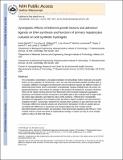Synergistic effects of tethered growth factors and adhesion ligands on DNA synthesis and function of primary hepatocytes cultured on soft synthetic hydrogels
Author(s)
Mehta, Geeta; Williams, Courtney M.; Alvarez, Luis; Lesniewski, Martha; Griffith, Linda G.; Kamm, Roger Dale; ... Show more Show less
DownloadGriffith_Synergistic effects.pdf (1.822Mb)
PUBLISHER_CC
Publisher with Creative Commons License
Creative Commons Attribution
Terms of use
Metadata
Show full item recordAbstract
The composition, presentation, and spatial orientation of extracellular matrix molecules and growth factors are key regulators of cell behavior. Here, we used self-assembling peptide nanofiber gels as a modular scaffold to investigate how fibronectin-derived adhesion ligands and different modes of epidermal growth factor (EGF) presentation synergistically regulate multiple facets of primary rat hepatocyte behavior in the context of a soft gel. In the presence of soluble EGF, inclusion of dimeric RGD and the heparin binding domain from fibronectin (HB) increased hepatocyte aggregation, spreading, and metabolic function compared to unmodified gels or gels modified with a single motif, but unlike rigid substrates, gels failed to induce DNA synthesis. Tethered EGF dramatically stimulated cell aggregation and spreading under all adhesive ligand conditions and also preserved metabolic function. Surprisingly, tethered EGF elicited DNA synthesis on gels with RGD and HB. Phenotypic differences between soluble and tethered EGF stimulation of cells on peptide gels are correlated with differences in expression and phosphorylation the EGF receptor and its heterodimerization partner ErbB2, and activation of the downstream signaling node ERK1/2. These modular matrices reveal new facets of hepatocellular biology in culture and may be more broadly useful in culture of other soft tissues.
Date issued
2010-03Department
Massachusetts Institute of Technology. Center for Environmental Health Sciences; Massachusetts Institute of Technology. Center for Gynepathology Research; Massachusetts Institute of Technology. Department of Biological Engineering; Massachusetts Institute of Technology. Department of Mechanical EngineeringJournal
Biomaterials
Publisher
Elsevier
Citation
Mehta, Geeta, Courtney M. Williams, Luis Alvarez, Martha Lesniewski, Roger D. Kamm, and Linda G. Griffith. “Synergistic Effects of Tethered Growth Factors and Adhesion Ligands on DNA Synthesis and Function of Primary Hepatocytes Cultured on Soft Synthetic Hydrogels.” Biomaterials 31, no. 17 (June 2010): 4657–4671.
Version: Author's final manuscript
ISSN
01429612
1878-5905